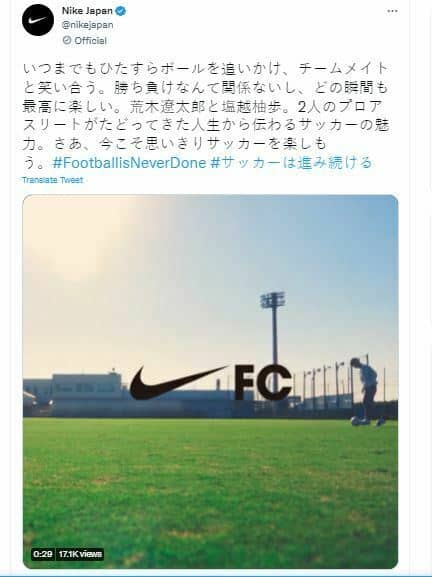It’s estimated that there are more than 5 billion social media users. Due to this, many companies have sought to utilize social media platforms for brand awareness and direct interaction with users.
However, what if you’re planning to attract international users that aren’t native English speakers?
We Are Social reported that 3 out of 10 users have to use online translation tools to get by to understand the content they come across online. With more than 6 out of 10 websites in English, it’s a struggle for many international users to find content in their native language.
Due to this, many companies have begun using auto translations for their social media content. With articles circulating on the internet about funny mistranslations on social media posts caused by automatic translation, some have been apprehensive about using it for social media marketing.
Today, we will discuss how you can effectively use auto-translation in your social media marketing strategy to appeal to your target and establish your brand.
Let’s get right to it!
International Users are Searching to Build a Community
Many small businesses seeking to cement their brand in new markets, digital marketing creates brand authority and engages with people on a human level that will benefit their business’s long-term growth.
The fastest and most direct way of engaging with users is through social media platforms where they are active. And it’s not just the small businesses that are using social media to garner users, numerous big brands effectively use social media to increase engagement and gather significant insights on their users’ preference.
You might be wondering what are the benefits to participating in an online community?
For users, there are several reasons why they would want to be a part of a community. They want to join an online community either for support for solutions to problems, discussion with like-minded individuals on interests, or be a part of goal-oriented actions.
At an emotional level, everyone wants to feel like they belong and many users find this in their online communities.
However, for a lot of international users, cultural and language barriers have made it difficult for them to connect with international brands.
CSA Research conducted a survey to thousands of online shoppers across 29 countries. They found out that 65% of users prefer content in their native language and 40% were not in buying from websites and marketing content that isn’t their language.
Many were to go so far and accept poor quality translations if it meant that they could read content in their language. This is sad. Your users deserve high quality multilingual content.
There have been technological and innovative means of overcoming these barriers, with the rise of automated translation. Many social media platforms have built-in translation tools to make your content multilingual.
Meta’s AI Machine Translation has made it possible for Facebook and Instagram to translate content into over 100 languages. What makes this MT model different from others is that it can adapt to non-English language pairs.
For example, French-Chinese language pair, instead of the French text translated to English before translating it to Chinese. This MT model will now be able to translate
them directly without making English the bridge between the two languages, making it more accurate.
The development of auto translation technology for these media platforms allows for streamlined interaction between non-English and native English-speaking users. It makes it easier for social media marketers to communicate with users, regardless of the language they speak.
Why Auto Translation is Unanimously Considered Inaccurate by the Internet
Since we have discussed the great benefits of auto translation, let’s discuss some of the reasons why the internet has a biased opinion of this technology. With articles having headlines like “Death by Machine Translation?,” it’s no wonder many users and companies are wary of using automatic translation tools.
However, there’s a good reason for this mistrust of this technology. From the above-mentioned article, the mistranslation from online automatic machine translation tools have caused a lot of problems due to users using it for official purposes, like translating legal and medical documents.
An example of how badly mistransations in social media can be is an incident that happened in Israel. In 2017, a young man posted on social media a picture of himself with captions in Arabic, which means “good morning.” The social media platform’s auto translation had it translated to “hurt them” in English and “attack them” in Hebrew. The young man was arrested due to the mistranslation.
However, what many people and companies tend to forget is that auto translation are just tools and nothing beats human expertise. Just using automatic translation isn’t enough you need to come up with a strategy to use it effectively.
How You Can Effectively Use Automated Translation to Engage with Your Target Users
Now that we have discussed the issues surrounding and controversy on the usage of automatic translation, we can talk about how you can use it for your social media marketing strategy.
Like with any tool, you must consider the different platforms you will be working with when automatizing your workflow. When implementing this tool, besides the cost, consider your business goals and if you’re willing to sacrifice quality as it might alienate your target users.
A vital aspect that companies often don’t pay more attention to is considering the type of automatic translation that runs under cloud-based software, like Google Cloud Translation AI, Azure Cognitive Services Translator, and Amazon Translate. Besides the skill of your language expert, selecting the proper MT system is crucial as you will need cutting-edge technology when you extract the content and begin to translate it.
According to this comprehensive guide on automatic translation, there are eight steps to optimizing the workflow with automated translation services, which will make localizing and translating any form of content quicker and more efficient:
Step 1. Project Management
Step 2. Reviewing the Content
Step 3. Extracting the Content
Step 4. Assigning Projects to Translators
Step 5. Translation Memory
Step 6. Evaluating Quality
Step 7. Launching the Content
Suppose you’re looking to save money but maintain quality. In that case, the middle ground has your workflow under Machine Translation Post-Editing, which combines advanced auto automatic machine translation with the expertise of translators to translate content quickly.
Below are some other considerations you will have to make when making your social media content strategy. Besides having a deep understanding of social media platforms, you will also need to have a good grasp of your target users.
Conduct Surveys and Market Research
Conducting surveys and market research is essential when developing a social media content strategy for users with different cultural and linguistic backgrounds. It’s not enough that you’re making your social media content in another language. You should make it relatable to your target market.
Surveys are a great way to measure customer satisfaction. By conducting surveys, you can get an idea about what your target users want to see on social media.
It can also give you a better idea of the demographics of your users, what pain points they’re experiencing, and what market gaps your business can provide. Not only that, you can gather your user’s contact information.
Market research should be your priority before you decide to create and translate content for social media. Many social media marketing campaigns fail abroad because they didn’t do adequate research on the target market they are planning to expand.
Market research could involve identifying what social media platform your target users are more active on. For example, Facebook isn’t where many Japanese users are active in Japan. Most Japanese users are active on Twitter as it’s their main source of information, like news updates, and where they can directly engage with experts and artists.
Suppose you didn’t know about this and planned to enter Japan. This could be problematic if you decided to focus your social media content marketing on Facebook rather than Twitter.
Besides knowing the social media platform your target audience prefers, market research is vital as you can also study your competitor’s marketing strategy and techniques. It will keep you updated with your target market’s latest trends while keeping in touch with your user’s cultural and linguistic preferences.
Researching your target market can give you an edge when repurposing and localizing your content for the country you’re planning to enter. Some countries have a more formal approach when marketing, while others are more receptive towards casual and humorous content.
By learning what’s the cultural practices for business and marketing in a country, you can better connect with your users at an emotional and personal level compared to simply translating content for the sake of it.
Geo-Target Specific Pages
After you’ve done your research on your target market, you can start creating geo-target-specific pages to make it easier for your users to look for you on the social media platform. To give you an understanding of how to do it effectively, let’s look at two companies that have successfully marketed their brand internationally.
Nike is an international company that has successfully marketed itself across different countries. Their official Facebook pages aren’t as active as compared to Twitter, Instagram, and Youtube.
They’re slogan: “Just do it.” May not have been translated but every caption and information found on their Nike Japan Twitter page is in Japanese. This tweet is a Nike video of professional Japanese soccer players, Ryotaro Araki and Yuho Shiokoshi, promoting the brand.


Their hashtags are in Japanese and English. Ex. #サッカーは進み続ける (Roughly translates to #Soccerkeepsgoing). It can be argued that the Japanese hashtag is a localized version of Nike’s #FootbalIisNeverDone.
This is perfect because in Japan, Soccer is one of the most popular sports. It’s another way to connect with avid soccer fans on a personal level through Ryotaro Araki and Yuho Shiokoshi’s talk about how their passion for soccer will never end.
Nike has used their platform as a way to promote its other social media platforms like LINE, which is popular in Japan. The cutesy cartoon for advertising is very distinctive in Japanese marketing, so the fact they used it to promote their free digital sticker online shows that they’ve done their research on their target users.

eToro is a well-known fintech software development company that originated in Israel. According to Marketing Twitter, they implemented their strategy First View campaign on Twitter. As a social trading network company, users can do pre-orders on shares.
Their campaign had a clear goal that their users could order their stock before public listing and that eToro is where they could do it. They focused on the Spanish and French markets, creating and monitoring Tweets in their native language.
At the end of their campaign, eToro saw an increase of engagement up to 9.6% and gained a 12% increase in positive brand sentiment on Twitter.
Have Linguistic Experts Manage Over Content Creation
From the above mentioned examples, it’s obvious that linguistic experts managed the content creation process. When looking through the automatic translations of some of the Tweets mentioned above, it was obvious that a human translator edited Twitter’s English translation version due to its coherence.

If you have stumbled across a Japanese Twitter account and used its auto-translation feature, it can be challenging to understand the English translation of it. And it’s not just for social media captions and editing the automated translations where you will need a language expert.
You will need language experts specializing in digital marketing to create visually captivating and story-oriented content for your social media platforms. As previously stated, automatic machine translation is just a tool. So to get the most out of it, working with marketing and language specialists for content creation is vital.
Building Presence on Social Media Platforms
Social media platforms have made it easier to track and monitor engagement. If you’re planning to enter a new market, creating a strategy to make your social media content and accounts relatable to your target audience should be your priority.
Automatic translation tools can be found across various social media platforms. However, many social media campaigns fail due to over-relying on them. And so, they come off as embarrassingly hilarious or very offensive.
Besides automatic machine translation, you will need language experts overseeing the captions and content creation for your geo-targeted social media pages. Hopefully, the tips and insights in this article will be useful when you begin creating a strategy for your brand on social media.


